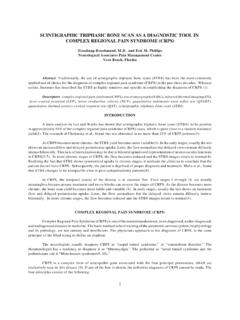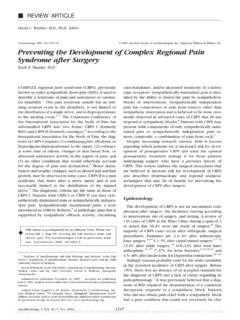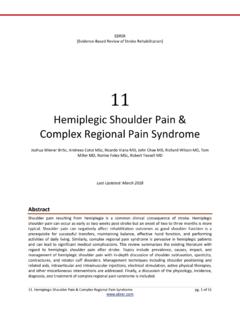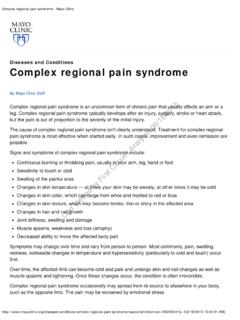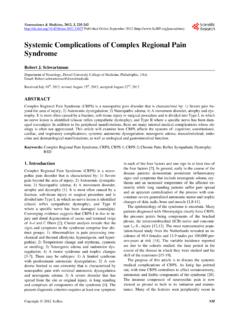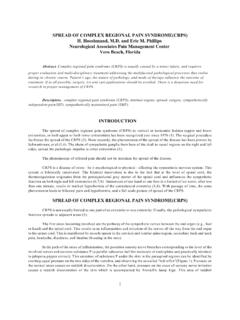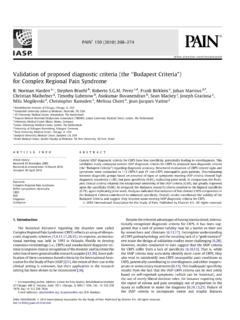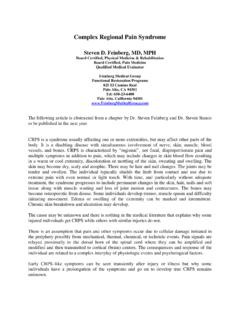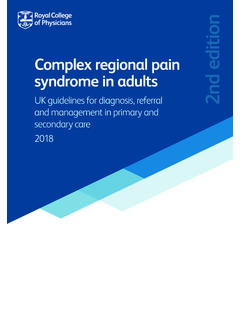Transcription of COMPLEX REGIONAL PAIN SYNDROME (CRPS) REFLEX …
1 1 COMPLEX REGIONAL pain SYNDROME ( crps ) REFLEX sympathetic dystrophy (RSD) DIAGNOSIS AND MANAGEMENT PROTOCOL Hooshang Hooshmand, , and Eric M. Phillips Neurological Associates pain Management Center Vero Beach, FL Abstract. COMPLEX REGIONAL pain SYNDROME ( crps ) / REFLEX sympathetic dystrophy (RSD) is a relatively rare neurologic disease. In the recent years, there has been an increasing awareness about the illness. The diagnosis of crps (RSD) is a diagnosis by inclusion rather than exclusion. Careful history taking, neurological evaluation, and understanding the nature of the components of crps (RSD) spares the patient from misdiagnosis and improper treatment. Descriptors.
2 COMPLEX REGIONAL pain SYNDROME ( crps ), REFLEX sympathetic dystrophy (RSD). INTRODUCTION COMPLEX REGIONAL pain SYNDROME ( crps ) / REFLEX sympathetic dystrophy (RSD) is a disease that usually starts after a relatively minor trauma. In the early stages there is a sympathetic component in the development of the disease, but with passage of time, quite frequently the somatic (non- sympathetic ) nervous system becomes involved as well. It is not a disease due to simple hyperactivity of the sympathetic nervous system. It shows dysfunction of sympathetic as well as somatic nervous system in the involved regions. ANATOMY Normally, there are two distinct sensory nerves. The somatic and the sympathetic . The somatic nervous system provides a variety of sensory modalities including fine touch, vibration, position sense, and well defined circumscribed pain .
3 The sensory input terminates in the post central parietal sensory cortex of the brain where it is perceived and modulated as a conscious, clear cut, focalized, well defined sensation. The sensory (afferent) portion of the sympathetic REFLEX arc, on the other hand, consists of a primitive sensory system which is not well defined, and can generate an unpleasant visceral and neuropathic pain . The pain is perceived as involving regions of the body such as upper or lower extremity. In contrast to the somatic sensory pain , the sympathetic sensory pain has a tendency to spread, and to generate referred pain (especially to paraspinal regions). Whereas the somatic sensory pain is felt in the 2distribution of the nerve roots (dermatomal radiculopathy), the sympathetic nerves have a tendency to follow the arteries (for control of body temperature), and follow the small arterial branches resulting in a thermatomal distribution of the pain .
4 PHYSIOLOGY OF sympathetic SYSTEM The sympathetic nervous system has three main functions. 1. Protection of internal environment of the body. Example: control of body temperature. 2. Control of vital signs (blood pressure, pulse, and respiration). sympathetic stimulation results in cold and wet skin (temperature preservation), increased heat and circulation in the muscle and bone, and elevation of pulse and BP. 3. Modulation of the immune system by up-or down- regulating the immune system response to any distress. The hyperimmune response leads to bouts of swelling, spontaneous bruises of skin, and fever. DIAGNOSTIC CRITERIA The diagnosis of crps (RSD) is a diagnosis by inclusion rather than exclusion.
5 The diagnostic tools consist of careful history and physical examination, triphasic bone scan (TBS), infrared thermal imaging (ITI), and other tests such as autonomic response test, or quantitative sudomotor response test (QSART). TBS testing is not sensitive enough to diagnose the crps . It is handicapped by the fact that the abnormality may be present bilaterally making it impossible to compare right side with the left. It is also quite variable in different stages of the disease. In addition, the test is nonspecific-imitating other conditions such as arthritis or Raynaud's Phenomenon. Lee and Weeks, and O'Donoghue, et al, have reported only 55-60% sensitivity for bone scans in diagnosis of crps (1, 2).
6 This means there is a 45% chance of missing the disease because the bone scan is reported as negative or nonspecific. ITI, on the other hand, is handicapped by the fact that the test is quite sensitive causing false positive results (3). ITI is only useful to identify areas of sympathetic nerve damage-but it cannot be used as the sole tool for the diagnosis of crps . crps can be diagnosed clinically by inclusion of a minimum of four principles (Table I) (4, 5). According to Benarroch the sensory nerve fibers originating the sympathetic response, eventually terminate almost exclusively in the limbic system (medial frontal and medial temporal lobe regions of the brain (6). As a result, in crps , the patient invariably suffers from limbic system dysfunction such as insomnia, agitation, irritability, depression, poor memory, and poor judgment (Table I).)
7 Using the above 3four strict criteria, other neuropathic pains such as diabetic neuropathy, myofascial SYNDROME , post herpetic neuralgia, etc., are excluded from the crps diagnosis. Table I. Clinical Diagnosis of crps (RSD) The following four criteria are necessary for diagnosis of crps (4, 5). 1. Neuropathic pain in the form of: a. Allodynic and hyperpathic pain elicited by simple stimuli that do not usually cause pain such as touch or breeze, and an exaggerated REGIONAL pain after simple stimulation. b. Hyperpathic pain : Increased sensitivity to touch (with objective sign of changes in sweating and rapid pulse in response to pain stimulation) with a tendency for secondary REGIONAL spread to the adjacent areas of the limb. 2. A motor response to the sensory stimulation.
8 A. Vasomotor (color and temperature changes of the extremity) b. Motor dysfunction (flexion deformity, muscle spasm, dystonia or tremor). 3. Inflammation a. Swelling of the extremity b. Neurodermatitis c. Spontaneous bruising d. Swelling causing entrapment mimicking carpal tunnel, tarsal tunnel, or thoracic outlet SYNDROME . 4. Limbic system dysfunction* a. Insomnia b. Irritability and agitation c. Poor memory d. Depression e. Poor judgment *The fourth principle, the disturbance of the limbic system function (the marginal part of the brain responsible for mood, memory, and judgment), is essential for definitive diagnosis of crps (5). DIAGNOSIS BY NERVE BLOCK Different types of nerve block tests such as guanethidine and phentolamine have been utilized for the diagnosis of crps (7, 8).
9 However, phentolamine tests are not performed anymore. Such tests are incapable of proving or ruling out crps . They only prove if the pain is a sympathetically maintained pain (SMP) or a sympathetically independent pain (SIP). In crps , in the first few months, the pain may be almost exclusively SMP. However, with the passage of time and with application of certain treatments (such as application of ice, cast, or assistive devices), the non- sympathetic 4nerve fibers become involved and the pain becomes SMP-SIP or purely SIP pain . This does not rule out the diagnosis of crps . The application of ice or immobilization of the extremity stimulates other mechanical or chemical sensory fibers which are independent of the sympathetic system.
10 The harmful effect of application of ice results in cold extremity and generates a new type of pain in the form of allodynia which is transmitted by sensory nerve fibers (A-delta nerve fibers) which are not a part of the REFLEX arch of the sympathetic system. The immobilization stimulates the chemoreceptor sensory fibers which are also independent of the sympathetic sensory fibers. So, the simple fact that the nerve block does not get rid of the pain does not rule out crps in later stages of the disease. In stage I (dysfunction), the pain is usually SMP in nature. In stage II (usually 3 months or longer after the trauma) the inflammation becomes more obvious ( dystrophy ) and the pain may be SMP or SIP.
